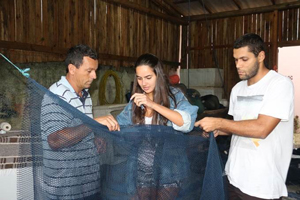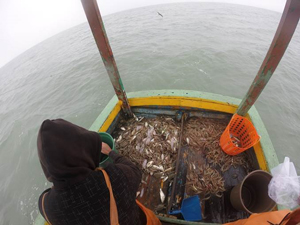Increased shrimp capture in Bycatch Reduction Devices after scientific experiments in a REBYC II – LAC pilot site
The Environmental Protected Area of Anhatomirim (EPAA) is a multi-stakeholder MPA (similar to IUCN Protected Area Category VI) located in the State of Santa Catarina, South-Southeast Brazilian coast and is one of the REBYC II – LAC pilot sites. Small-scale shrimp trawling is one of the main fisheries in the region, with 18-90hp engine boats, using mostly double-rigged otter trawls.
Bycatch reduction strategies are clearly addressed in the management plan since its publication in 2013. It's the first case where fishing regulation indicates bycatch reduction devices (BRDs) as a management tool in Brazil. The management plan also draws a marine zoning where scientific experiments and demonstrations should be conducted in order to support fishing regulation based on bycatch reduction in trawl fisheries.
Addressing bycatch in the management plan is one of the outcomes from a participatory research conducted since 2011 in the Environmental Protected Area of Anhatomirim. Experiment and demonstration hauls using different BRDs, such as, square-meshed codend and escape panels, Nordmore grids, as well as modifications proposed by fishers, such as, reducing the distance between the codend and the trawl mouth, painting the web, and a "balloon" system (tunnels with 2x the codend circumference placed before the codend) were tested.
With support from REBYC II – LAC scientific experiments have been conducted from May to July. We used three modifications with expected decreasing level of bycatch exclusion: Test 1- Nordmore grid (17mm space bars) combined with a painted web codend in a 18hp doubled-rigged trawler; Test 2 - Nordmore grid (30mm space bars) combined with a painted web codend in a 22hp single-rigged trawler and Test 3 - Square-meshed codend combined with a "baloon" in a 60hp double-rigged trawler.
Experiments showed satisfactory, otherwise preliminary results. The designs for these BRDs resulted from experience of six years of investigation in order to find an optimal condition between maximum reduction of discards, minimal loss of byproduct (important for food security and as sub-product in the fish supply chain) and no significant loss of shrimp. When compared to control nets, BRDs showed increase in Atlantic Seabob shrimp (Xiphopenaeus kroyeri) capture on Test 2 and Test 3 of 30% and 14%, respectively. Otherwise, Test 1 showed a reduction of 23%, not significant at statistical level. Also, the fisher supporting the experiments perceived the loss as not relevant due the benefit of reducing bycatch. After first hauls, the fisher adjusted the net and shrimp losses were reduced.
 |
|
Fisher and students preparing the 17mm space bars Nordmore Grid for |
Gradual bycatch reduction occurred as expected, with 65% in Test 1, 42% Test 2 and 8% in Test 3. All BRDs showed higher ratio Seabob catch / Bycatch, with better results when using Nordmore grids. Women engaged in peeling shrimp also perceived improvement in their labor conditions, with bigger shrimps to process, shifting the ratio raw shrimp / peeled shrimp from 4:1 to 2.5:1 when using the Nordmore grid (30mm space bars).
Fishers directly contributed to the results by being open-minded to participate in the experiments as well as taking initiatives to improve BRDs design and performance. Researchers, managers and fishers are enthusiastics on the potential outcomes for fisheries management. Voluntary adoption is still challenging, and implementation of BRDs as management tools will depend on a continued dialog to share experiences and to develop strategies to the effective use of BRDs in daily fishing. Next steps as a REBYC II – LAC pilot site include developing and experiment these strategies in the context of EPAA management plan implementation.
Written by Dáfne Sampaio and Rodrigo P. Medeiros (REBYC II LAC – EPAA research team)

